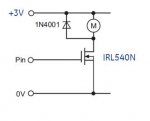A typical LED, fully iluminated, will draw just about all of the current a PICAXE can source. Also, the typical LED will drop about 2 volts across it when it's on. That means the PICAXE output voltage at the top of the diode will be held down at 2 volts.
If you add a resistor in series with the LED to limit its current to 10mA or so (try a 330 Ohm one,) and to drop the difference between the 5 volts and the 2 volts, you may still be able to run both circuits on the PICAXE output. The LED will be a bit dimmer, but will still light, and the resistor will drop about 3 volts, while the LED will drop about 2 volts, leaving the FET gate voltage high enough for the FET to be fully turned on. The FET really needs to see nearly all of that 5 volts in order for its internal resistance to drop to fractional ohms of resistance so the motor will get full power.
As is, it requires specially designed MOSFET's in order to have the gates turn on fully at voltages as low as 5 V. Most of them require closer to 8 to 10 volts for full turn-on.


